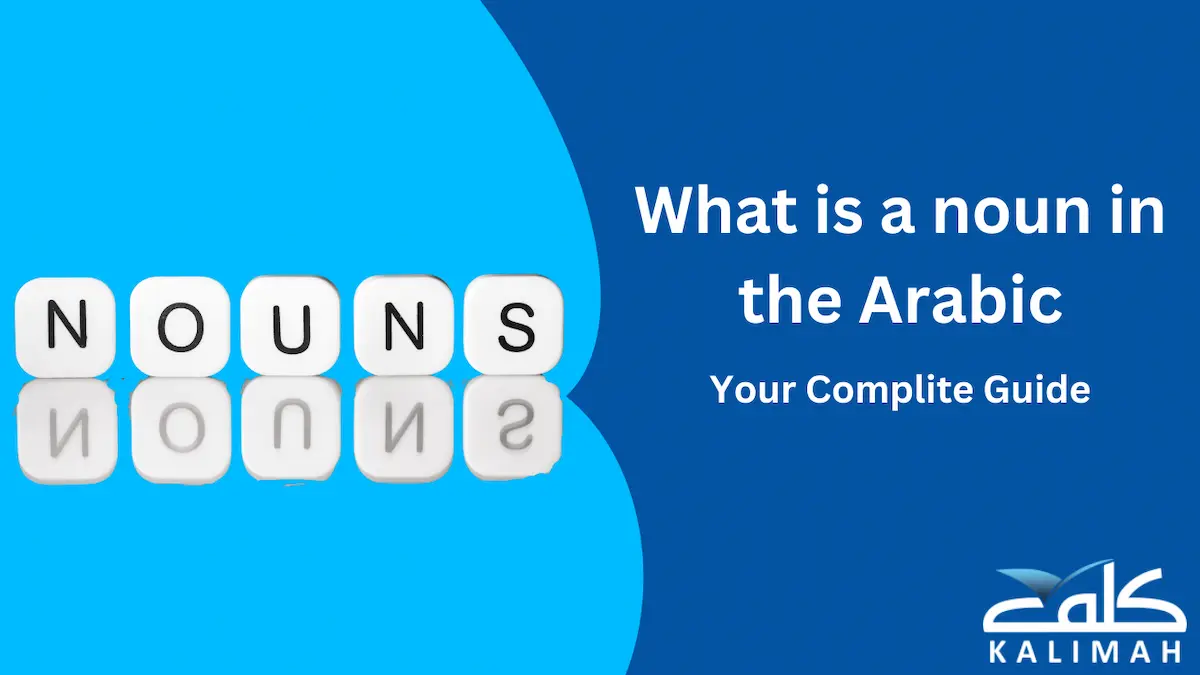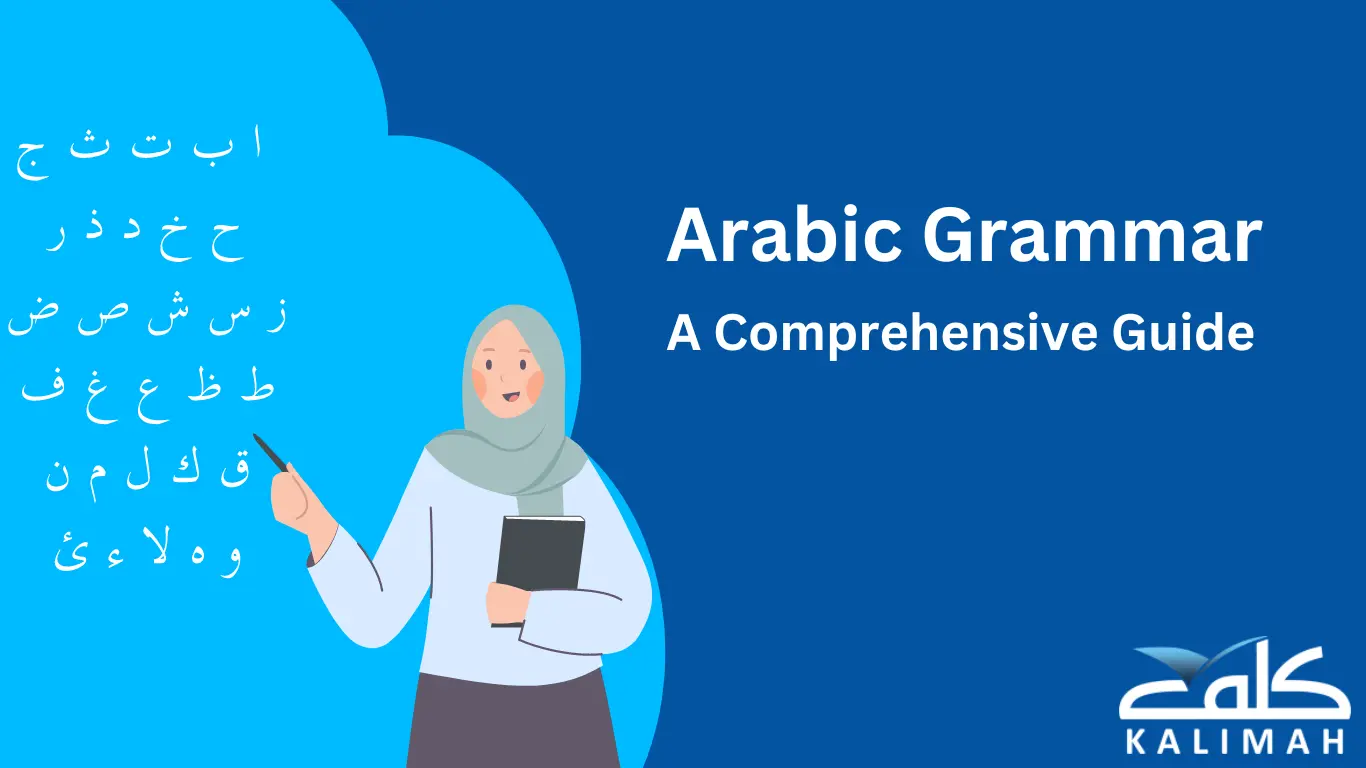The morphological structure of nouns in Arabic is a complex and multifaceted subject, However, gaining an insight into this subject enables you to explore the beauty and accuracy of the Arabic language. In this article, you will learn all about Arabic nouns, their types, uses and examples.
What is a noun in the Arabic language?
A noun in Arabic is referred to as “ism- اسم” which is a word that can stand alone and does not need the help of another word to explain its meaning. A noun can be the name of a person, place, or thing, it can also include adjective nouns.
-
Examples of Arabic Nouns
Examples of nouns include “the house – الْبَيْت” and “the Mosque – المَسْجِد”, “the beautiful garden – الحَدِيقة الجَمِيلَة” and “the little girl – الفَتاة الصَغِيرَة”.
Types of Arabic nouns
Arabic nouns can be classified according to several factors including
- Gender: According to the gender Arabic nouns can be classified into two categories masculine and feminine.
- Plurality: According to the number, Arabic nouns are classified into singular dual and plural nouns.
- Definiteness: Arabic nouns are classified into definite and indefinite nouns.
- Derivation: Arabic nouns can also be classified into derived nouns (اسم مُشتَق) and non-derived (اسم جَامِد).
Definite and indefinite nouns and their types
Arabic nouns are classified into two categories which are definite nouns ( المعرفة – Almaarefa) and indefinite nouns ( النكرة – Alnakera). Let us discuss each of them in detail.
-
Indefinite Arabic Nouns
These are nouns that refer to non-specific or unknown persons, places or objects.
An example of an indefinite Arabic noun is the word “Bayt – بَيْت” which means house.
-
Definite Arabic Nouns
The Arabic language has a type of nouns called “المعرفة” (Al-Ma’rifa), also known as definite nouns.
This kind of noun refers to a specific person, animal, place, or thing that the speaker and listener are already familiar with.
There are several ways to identify the definite noun, including:
- Adding the article “ال” (Al-),
- Using a pronoun (e.g. He- هُوَ, She – هِيَ, …etc.)
- Using a proper noun, or “Alam – عَلَم (e.g. Mohammed- مُحَمَّد)
- Using a demonstrative noun (e.g. This – هذا)
- Using a relative noun (e.g. Al-addhi – الَّذِي)
- Using the word “يا” (Ya) to call someone (e.g. O kids – يا أطفال)
- Adding an indefinite noun to the definite noun (“المضاف إلى المعرفة”), (e.g. hadiqat al manzil – حَدِيقة المَنْزِل – the garden of the house)
Therefore, when using the definite noun, the speaker is referring to something that has already been introduced or is already known to the listener.
Nouns in Gender and Number
Understanding the gender and number of Arabic nouns is crucial for proper usage and communication in Arabic. Hence, let’s discuss some of the Arabic grammar rules related to this important subject.
-
The Gender of Arabic Nouns
Arabic nouns have two genders, with all nouns (animate and inanimate) classified as either masculine or feminine. The gender of a noun is assigned based on semantic criteria (natural gender) and formal properties (morphological form).
The masculine is the default unmarked form, while the feminine form is usually the marked one.
Most feminine nouns are morphologically marked for gender by one of the three feminine suffixes, taa’ marbuta (التَاء المَرْبُوطَة), Alif alta’neeth al maqsoura (ألِف التأنيث المَقْصورة), and Alif al ta’neeth al mamdooda ( أَلِف التأنِيث المَمدودَة). See the table below for examples:
| Feminine Suffix | Example |
| taa’ marbuta (التَاء المَرْبُوطَة) | الْطِفْلَةAl-TeflahThe little girl |
| Alif alta’neeth al maqsoura (ألِف التأنيث المَقْصورة) | الْكُبْرَىAl-Kobra
The grand |
| Alif al ta’neeth al mamdooda ( أَلِف التأنِيث المَمدودَة) | البيضَاءAl-Baidaa’
The white |
However, there are feminine nouns that have no marked endings, and their feminine gender is known through the semantic meaning.
Note that the other parts of speech (including verbs and pronouns) should show gender agreement with the noun.
-
The Number of Arabic Nouns
The Arabic language is unique as it has three numbers: singular, dual, and plural. The singular form is called “wahid – وَاحِد” or “mufrad – مُفْرَد”, the dual form is named “Muthana – مُثَنَّى”, and the plural form is known as “jame’ – جَمْع”.
-
Singular Arabic Nouns
Singular Arabic nouns are referred to as “Wahid – وَاحِد” or “Murad – مُفرَد”. Examples of singular Arabic nouns are:
Al kitab – الكِتَاب (the book).
Al Ragul – الرَّجُل (the man).
-
Dual Arabic Nouns
In Arabic, the dual form ends with the suffix “ان – aan” and some examples of the dual form are “al-rajulaan – الرَّجُلَان” (two men) and “al-mar’ataan -الْمَرْأتَان” (two women).
-
Plural Arabic Nouns
In Arabic, there are two types of plural forms; sound plural (الجمع السَالِم) and broken plural ( جَمْع التَكْسِير). These two types can be summarized as follows:
Sound Plural
The masculine plural of nouns in Arabic is formed by adding “ون” to the singular form, e.g. “Muslim- مُسْلِم” becomes “Muslimun – مُسْلِمُون”.
While the feminine plural of nouns that end in “ة” is formed by changing “ة” into “ات”, e.g. “Muslima – مُسْلِمَة” which becomes “Muslimat – مُسْلِمَات”.
The feminine plural form of nouns that do not end in “ة” is formed by adding “ات” to the singular form, e.g. “Samaa’ – سَمَاء – sky” becomes “Samawat – سماوات – skies”.
Note that, in Arabic, even adjectives have dual and plural forms, which is different from English where adjectives have no plural form.
Broken Plural (Jame’ al takseer – جَمْع التَكْسِير)
The broken plural is a grammatical feature in Arabic that is extensively used in the language. It is formed from the singular form of a word by either adding or removing consonants, or by changing vowels.
For example, the word “kitab – كِتَاب” (book) becomes “kutub – كُتُب” in its broken plural form.
Another example is “rajul – رَجُل” (man), which becomes “rijal – رِجَال” in its broken plural form.
Additionally, in Arabic, it is not uncommon for a noun to have multiple broken plurals. For example, the word for “brother – أَخ” has several broken plurals including أخوة, إخوان, إخوة, أخية, or even to have both the sound plural and broken plural forms.
The word for “prophet – نَبِيّ” has a sound plural of نَبِيُّون and a broken plural of أَنْبِيَاء.
This complexity in plural forms is unique to the Arabic language and can make it challenging for non-native speakers to learn. However, with practice, you can easily master this subject.
Arabic Noun Derivation
Arabic is a language with a rich and complex morphological structure, particularly when it comes to forming nouns.
Interestingly, unlike English, forming a noun in Standard Arabic requires a change in the internal structure or building of a word, rather than simply adding an affix.
Do derived Arabic nouns depend on gender?
Yes, the derivation of Arabic nouns depends on the gender of the subject. Let’s take a closer look at some examples.
The word “mualim” (معلم) means “teacher” and is masculine. To make it feminine, we add the suffix “-a” to the end, resulting in “mualima” (معلمة).
The word “talib” (طالب) means “student” and is masculine. To make it feminine, we add the suffix “-a” to the end, resulting in “taliba” (طالبة).
So, to summarize, the suffix “-a” is added to the end of masculine nouns to make them feminine in Arabic.
The Classification of Derived Nouns in Modern Standard Arabic
In the Arabic language, derived nouns are categorized based on their functions in sentences. Below are some examples of derived Arabic nouns:
-
Noun of the subject (اسم الفاعِل)
It refers to the person or entity that performs an action. This type can be derived from a triliteral verb that follows the pattern of (fa’il – فَاعِل), such as kataba – كَتَبَ , which becomes Katib – كَاتِب (writer), Nasara – نَصَرَ , which becomes Naser – نَاصِر (helper) and so on.
Additionally, subject Arabic nouns can be derived from verbs other than triliteral verbs. An example of a noun which is derived from a non-triliteral verb is: the verb Intasara – انْتَصَرَ from which the subject noun muntasir – مُنْتَصِر is derived.
-
Exaggeration Form ( صيغة المُبَالَغَة )
When we want to emphasize and highlight an action’s increase, we can use exaggeration (sighat al mubalagha – صيغة المُبَالغة) form of the subject’s noun.
For instance, we can change “Wahib – وَاهِب”, meaning giver, to “Waha’b – وَهَّاب” and “Shakir – شَاكِر” to “Shakoor – شَكُور”.
The exaggerated form of “Shakir” means a person who expresses gratitude on a wide scale. This form serves the same function as the subject noun.
-
Noun of the object (اسم المَفْعُول)
This type of noun is known as a passive participle or “ism al-maf’ool – اسم المَفْعُول” in Arabic grammar. It refers to the person who is the object of an action, such as the recipient of a verb.
Examples of passive participles include, “mansoor – مَنْصُور” (helped), “maqtoob – مَكْتُوب” (written), “maqbool – مَقْبُول” (accepted), “mukaram – مُكَرَّم” (honored), “mustakhraj – مُسْتَخْرَج” (extracted), and “muratab – مُرَتَّب” (organized).
-
Preference Noun (Ism al tafdeel- اسْم التَفْضِيل)
This type is used to express a likeness between two people or things through an adjective in which one of them increases more than the other: for example, Akbar – أَكْبَر, meaning bigger, and afdhal – أَفْضَل, meaning better.
-
Time and Place Nouns (اسم الزمان واسم المَكَان)
Time and place nouns are derived from verbs to indicate when or where an action takes place. For example, “madrassa – مَدْرَسَة” means school which is derived from “Darasa – دَرَسَ – to study”, and “mazra’a” means farm which is derived from the verb “zara’a – زَرَعَ – to plant”. By using these nouns, we can convey important information about the setting and context of the action being described.
-
Instrument Noun ( اسم الآلَة)
In the context of Arabic grammar, the term ‘instrument noun’ or “ism al-ala – اسْم الآلة” is used to refer to a tool or device that is used to carry out a particular action.
In the Arabic language, the words ‘Midraqa – مِطْرَقَة (hammer), “Sayyara – سَيَّارَة (car), and “Ghassala – غَسَّالة (washing machine) are all examples of instrument nouns.
Grammatical Rules of Nouns in Arabic
In Arabic, most nouns undergo grammatical inflection and can enter various grammatical cases based on their usage within a sentence. However, not all nouns display their case in the same way. For more details on this subject refer to our Arabic Grammar comprehensive guide.
To Sum Up
Nouns in Arabic is one of the most important subjects that should be carefully studied by Arabic learners, especially beginners. However, with deep understanding and practice of the patterns and rules of Arabic nouns you can easily grasp the subject and take your Arabic language skills to the next level.
Learn Arabic Nouns with Kalimah!
Now, learning the intricacies of the Arabic language has become easier than ever, thanks to the new interactive Arabic teaching platforms. Join Kalimah Online Arabic Course today and take your first step towards mastery of Arabic!
🚀 Start Your Free Trial Today! 🚀
Don’t miss out on this life-changing opportunity to deepen your faith and knowledge. Sign up now for your free trial and take the first step towards becoming a better practicing Muslim with Kalimah Center!
FAQs
What are the types of nouns in Arabic?
As we previously mentioned, there are several ways to classify Arabic pronouns; since this depends on various factors including gender, plurality, definiteness, and derivation.
How many noun cases are in Arabic?
The Arabic language has three different noun cases. This means that the case of each noun varies according to its position and function in every sentence.
What are the three cases for nouns in Arabic?
The three Arabic noun cases are the nominative ( marfoo’ – مَرْفُوع), accusative ( mansoub – مَنْصُوب), and genitive (Majrour – مَجْرُور) cases.
Is the Quran a common noun?
The word Quran is considered one of the proper nouns (Alam – عَلَم) when it is preceded by (Al – ال) referring to the Holy Quran revealed to Prophet Muhammad. However, in some cases the word Quran can be used as a common noun, in this case it may refer to either a part of the Quran or any other text that is “maqroo’ – read”.
Do Arabic nouns have gender?
Yes, Arabic nouns have two genders, which means they can be either masculine or feminine.















